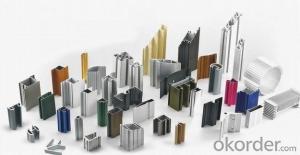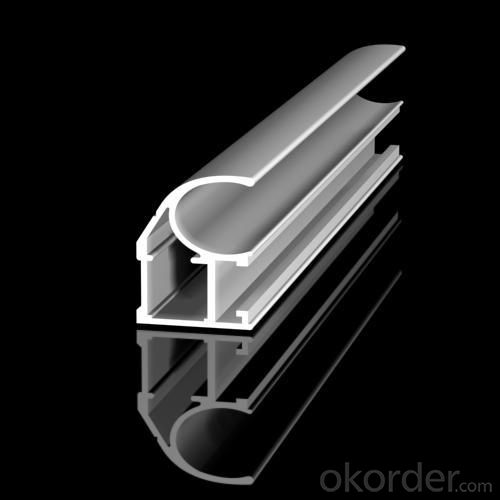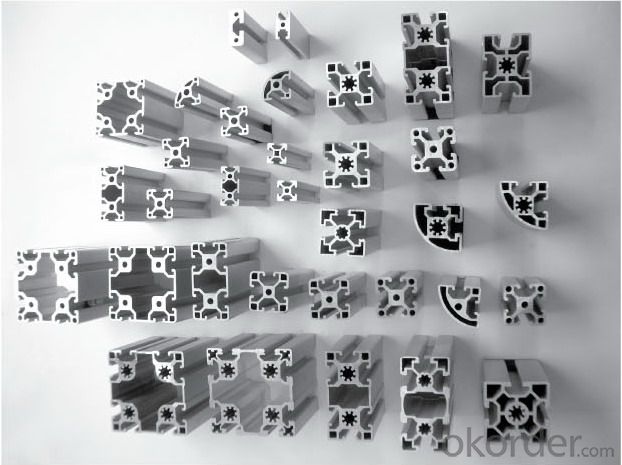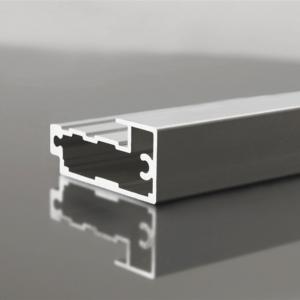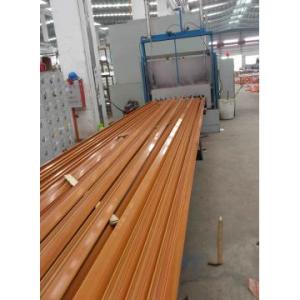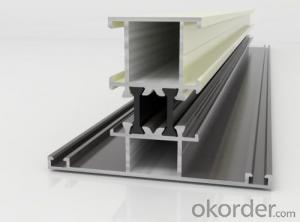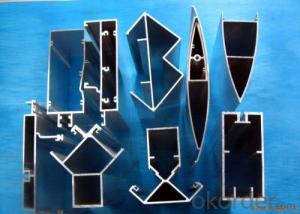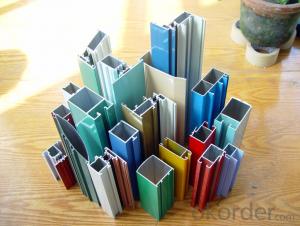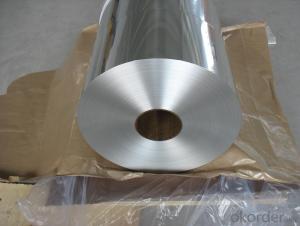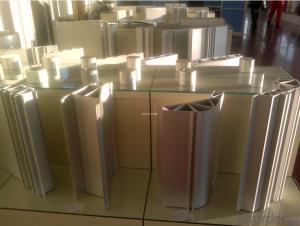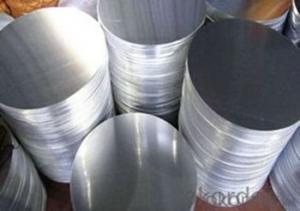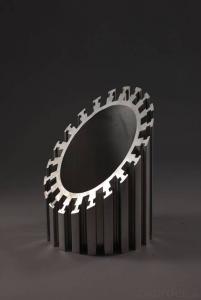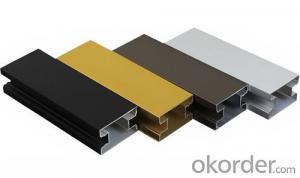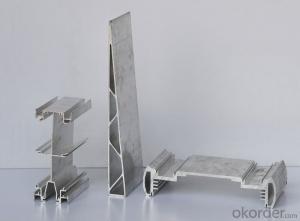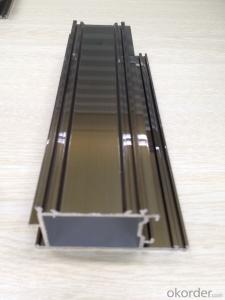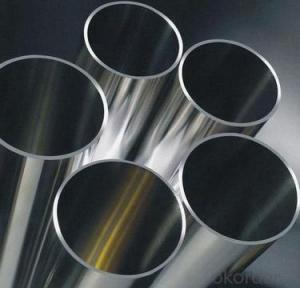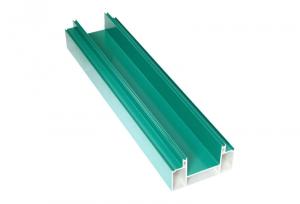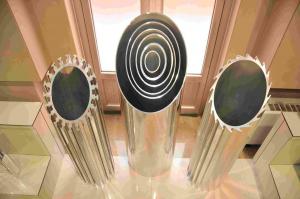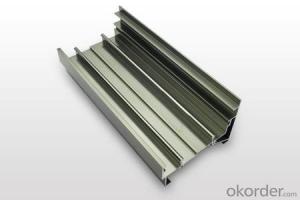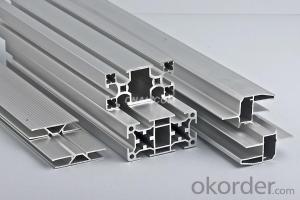Structural Aluminum Profiles for Industrial Material
- Loading Port:
- Guangzhou
- Payment Terms:
- TT OR LC
- Min Order Qty:
- 5 m.t.
- Supply Capability:
- 1000 m.t./month
OKorder Service Pledge
OKorder Financial Service
You Might Also Like
Specification
1.Structure of Aluminium Profile for Industrial Material Description:
Anodizing (also spelled anodising, particularly in the UK and Australia) is an electrolytic passivation process used to increase the thickness of the natural oxide layer on the surface of metal parts. Anodized aluminium surfaces, for example, are harder than aluminium but have low to moderate wear resistance that can be improved with increasing thickness or by applying suitable sealing substances.
2.Main Features of the Aluminium Profile for Industrial Material :
High corrosion-resistance;
weather-resistance;
heat-resistance;
alkali-resistance and impact-resistance properties.
3.Aluminium Profile for Industrial Material Images:
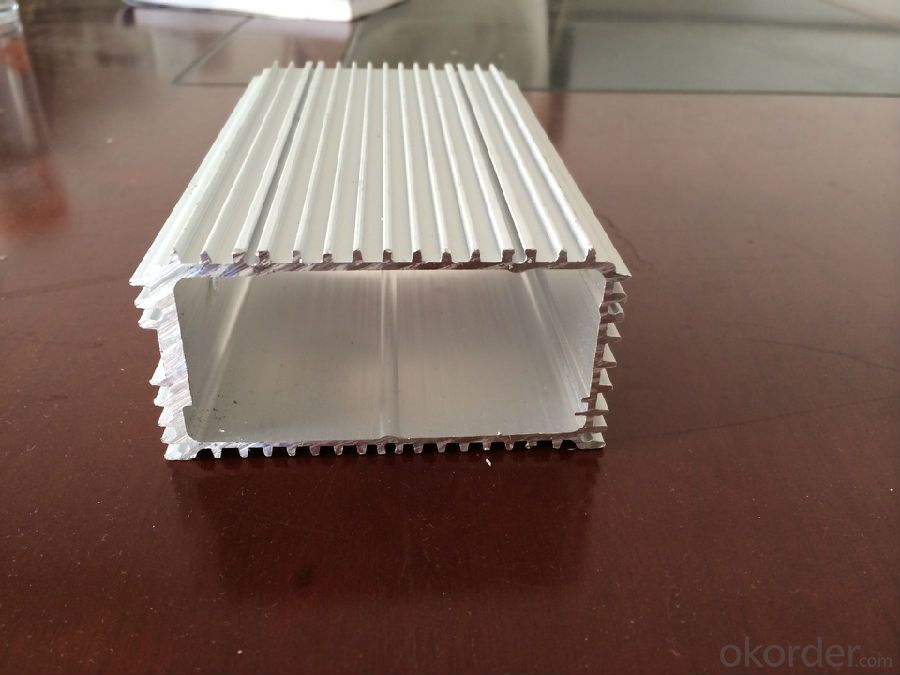
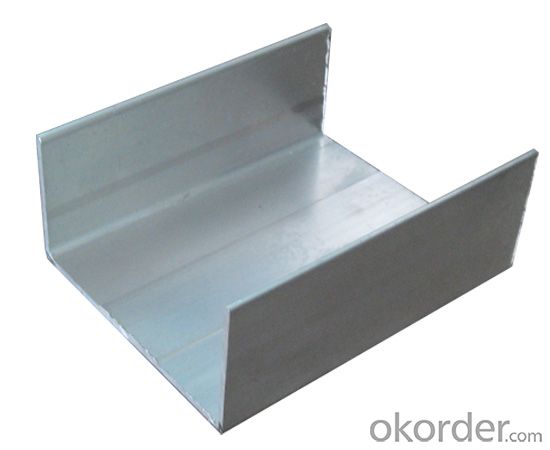
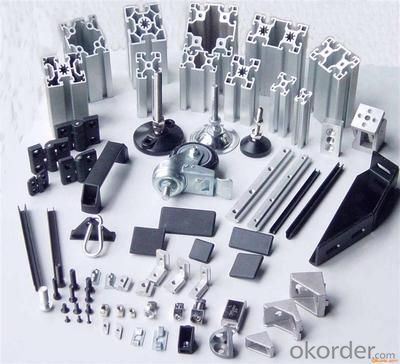
4.Aluminium Profile for Industrial Material Specification:
1. Material: 6063,6061,6060,6005,6005A,etc.
2. Temper: T5 or T6
3. Finish: Mill finish, anodizing, powder coating, electrophoresis, wooden transfer or pvdf/carbon-flouride coated, polishing, brushing, sand blasting
4. Various colors: Silver, bronze, black, gold, blue, grey, champagne, bright, etc.
5. Machining: Cutting, punching, drilling, tapping, milling, bending, welding, CNC etc.
5.FAQ:
①How about your company?
A world class manufacturer & supplier of castings forging in carbon steel and alloy steel,is one of the large-scale professional investment casting production bases in China, consisting of both casting foundry forging and machining factory. Annually more than 8000 tons Precision casting and forging parts are exported to markets in Europe, America and Japan. OEM casting and forging service available according to customer’s requirements.
②How to guarantee the quality of the products?
We have established the international advanced quality management system,every link from raw material to final product we have strict quality test;We resolutely put an end to unqualified products flowing into the market. At the same time, we will provide necessary follow-up service assurance.
- Q: Can aluminum profiles be used for modular office partitions?
- Modular office partitions can indeed utilize aluminum profiles. These profiles possess characteristics such as lightness, durability, and a high strength-to-weight ratio, rendering them a perfect choice for constructing such partitions. They can be effortlessly transformed into different forms and sizes, thereby enabling customization and design flexibility. Moreover, aluminum profiles exhibit outstanding resistance against corrosion, guaranteeing prolonged performance even when exposed to high humidity conditions. Furthermore, they offer commendable thermal and sound insulation properties, thereby contributing to a pleasant and efficient office ambiance. In summary, owing to their versatility, durability, and aesthetic appeal, aluminum profiles remain a popular preference for modular office partitions.
- Q: This question asks for methods to guarantee the high quality of aluminum profiles used in a construction project.
- <p>To ensure high-quality aluminum profiles for your building project, start by selecting profiles from reputable manufacturers known for quality. Check for certifications such as ISO 9001 for quality management systems. Inspect the profiles for uniformity in thickness and color, and ensure they are free from defects like dents or scratches. Request third-party test reports to verify the strength and durability of the profiles. Additionally, consider the chemical composition and alloy type to ensure they meet the required specifications for your project. Always procure from suppliers who offer warranties and after-sales support.</p>
- Q: What are the different surface protection coatings for aluminum profiles?
- Aluminum profiles have a wide range of surface protection coatings available, each with unique benefits and applications. Here are some common options to consider: 1. Anodizing: Anodizing is a popular coating method that creates a protective layer on the aluminum surface. It improves corrosion resistance, durability, and aesthetics. Anodized coatings can be clear or colored, offering design flexibility. 2. Powder coating: For durability and versatility, powder coating is a preferred choice. This method involves electrostatically applying dry powder to the surface, which is then cured under heat to form a protective layer. Powder coatings provide excellent resistance to UV rays, chemicals, and scratches, along with a wide range of color options. 3. Liquid paint coating: Another option is liquid paint coatings, which involve applying a liquid paint to the surface and curing it to create a protective film. These coatings offer customization in terms of color and finish, allowing for specific design requirements. 4. E-coating: E-coating, also known as electrocoating or electrodeposition, utilizes an electric current to apply a paint or coating to aluminum profiles. This process ensures a uniform and consistent coating, resulting in excellent corrosion resistance and durability. E-coatings are commonly used in automotive and industrial applications. 5. Ceramic coatings: Ceramic coatings, a newer option, consist of inorganic materials that provide exceptional hardness, heat resistance, and chemical resistance. These coatings are ideal for enhancing performance and lifespan in harsh environments like marine or aerospace applications. When selecting a surface protection coating, it is essential to consider the specific requirements and intended use of the aluminum profiles. Factors such as corrosion resistance, durability, aesthetics, and cost should be taken into account to determine the most suitable option.
- Q: This question asks for a list of various fastening methods used to connect aluminum profiles to the structural frames of buildings.
- <p>There are several types of fasteners used to attach aluminum profiles to building frames, including: 1) Bolts and Nuts: Commonly used for strong, secure connections. 2) Rivets: Provide a permanent connection that is resistant to vibration. 3) Self-Tapping Screws: Can be used in materials without pre-drilling. 4) Structural Glue: Offers a strong bond and is often used in combination with mechanical fasteners. 5) Welding: Used for permanent, load-bearing connections, though not common for aluminum due to the risk of thermal distortion. 6) Clamps and Brackets: Used for temporary or adjustable connections. 7) Adhesive Tapes: Provide a quick and easy method of attachment, though not as strong as other methods. Each type of fastener has its own advantages and is chosen based on the specific requirements of the construction project.</p>
- Q: Is it possible to utilize aluminum profiles as part of the exterior cladding systems for commercial buildings?
- <p>Yes, aluminum profiles are commonly used for exterior cladding systems in commercial buildings. They offer several advantages such as durability, resistance to weather and corrosion, low maintenance, and a modern aesthetic. Aluminum's lightweight nature and strength make it an ideal material for cladding, and it can be easily shaped and joined to create a variety of designs. Additionally, aluminum profiles can be coated or anodized to provide color and further protection against the elements.</p>
- Q: Including the element parameters, the price and the difference between 6063, what is the use and so on!How about 6060 100/ meters? How much is the strength? How much is the price more than 6063?
- It has many valuable features: 1. heat treatment, high impact toughness, plasticity of missing insensitive.2. has excellent heat, can be squeezed into a high speed complex structure. The hollow thin wall. Various profiles or forged into the complex structure of the forging, quenching temperature range quenching, low sensitivity, extrusion and forging after stripping, as long as the temperature is higher than the quenching temperature. The quenching method available water or water in thin walled parts (6.
- Q: This question asks for a method to determine the quantity of aluminum profiles required for a construction project.
- <p>To calculate the amount of aluminum profiles needed for a building project, follow these steps: 1. Determine the design specifications and dimensions of the project, including the length, width, and height of the structure. 2. Identify the types and sizes of aluminum profiles required based on the structural needs and design. 3. Calculate the total linear footage of each profile type needed by multiplying the length of each required section by the number of sections. 4. Add up the total linear footage for all profile types. 5. Account for waste and cutting losses, typically adding 5-10% to the total. 6. Ensure the calculations comply with building codes and safety standards. Consult with engineers or architects if necessary.</p>
- Q: Are aluminum profiles suitable for use in mining and construction equipment?
- Yes, aluminum profiles are suitable for use in mining and construction equipment. Aluminum is a lightweight and durable material that offers excellent corrosion resistance, making it ideal for heavy-duty applications in these industries. Additionally, aluminum profiles can be easily customized and fabricated to meet specific design requirements, enhancing their suitability for use in mining and construction equipment.
- Q: Are aluminum profiles suitable for exhibition displays?
- Yes, aluminum profiles are suitable for exhibition displays. Aluminum is a lightweight and durable material, making it ideal for creating modular structures that can be easily transported and assembled at different exhibition venues. These profiles can be used to construct display walls, stands, booths, and other exhibition components. One of the main advantages of using aluminum profiles for exhibition displays is their versatility. They can be easily customized and adapted to meet specific design requirements, allowing for the creation of unique and eye-catching displays. Additionally, aluminum profiles can be easily connected and disassembled, making them a practical choice for exhibitions that require frequent setup and teardown. Another benefit of using aluminum profiles for exhibition displays is their aesthetic appeal. Aluminum has a sleek and modern look that can enhance the overall visual impact of the exhibition. It can be finished with various coatings or colors to match the branding or theme of the event, further enhancing the overall presentation. Furthermore, aluminum profiles offer great stability and strength, ensuring that exhibition displays can withstand the rigors of a busy exhibition environment. They are also resistant to corrosion, which is important when considering the longevity and durability of the display. In summary, aluminum profiles are a suitable choice for exhibition displays due to their lightweight, durability, versatility, aesthetic appeal, and strength. They provide the necessary stability and can be easily customized to create visually appealing and functional exhibition displays.
- Q: Are aluminum profiles weather-resistant?
- Yes, aluminum profiles are weather-resistant. Aluminum is known for its excellent corrosion resistance and ability to withstand various weather conditions such as rain, snow, UV radiation, and extreme temperatures. This makes aluminum profiles a popular choice for outdoor applications such as windows, doors, and outdoor furniture.
Send your message to us
Structural Aluminum Profiles for Industrial Material
- Loading Port:
- Guangzhou
- Payment Terms:
- TT OR LC
- Min Order Qty:
- 5 m.t.
- Supply Capability:
- 1000 m.t./month
OKorder Service Pledge
OKorder Financial Service
Similar products
Hot products
Hot Searches
Related keywords
